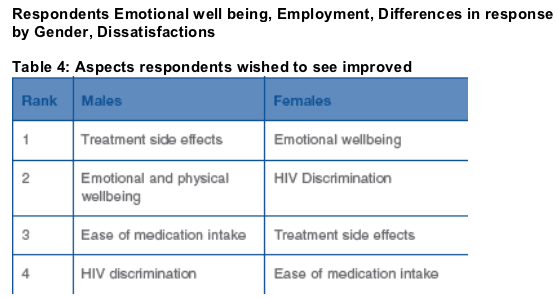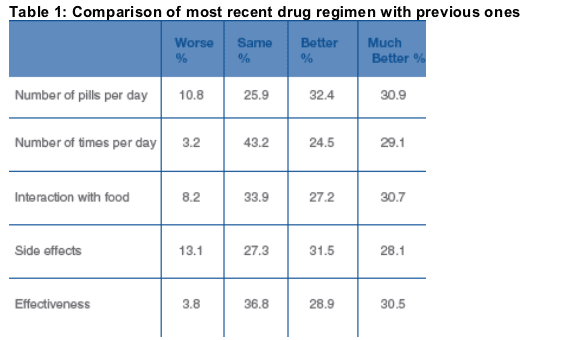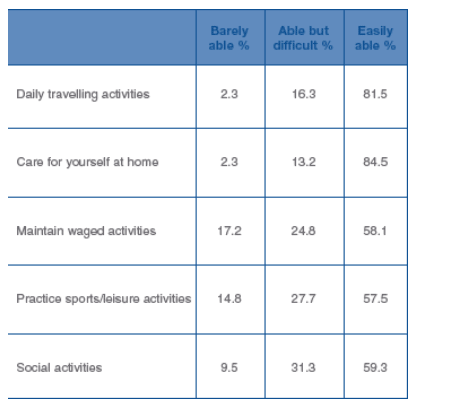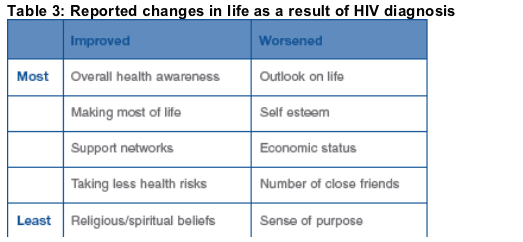 |
 |
 |
| |
HIV+ Patient Survey: 52% Dissatisfied with Quality of Life
|
| |
| |
Brief Summary of survey among HIV+ Europeans regarding their HIV:
".....52% don't report much or any satisfaction with their overall quality-of-life...85% worried about possible liver toxicity...despite improvements in dosing, 78% would like improved ease in taking medications....51% felt conscious of their HIV status some of the time and 44% most or all the time....Embarrassment about status, anxiety and depressive moods are the most experienced feelings.....Future body shape changes, increased symptom visibility and physical disability were ranked among the top 3 causes of concern for the future......The majority of respondents felt that their diagnosis had the most impact on their relationship/marriage. Their ability to provide for family/care for children, to maintain social networks and employment were also negatively affected by their HIV status....45% reported moderate to a lot of fatigue. Fatigue is a major source of complaint, and of concern for the maintenance of work prospects......
.....55% were university graduates of equivalent....69% were in employment (1/4 worked part-time). Of these, 30% previously had to quit employment for HIV-related medical reasons for 6+ months...34% needed to reduce their working hours as a result of their health. 58% felt their diagnosis could affect their career
opportunities....Sexual frustration ranked highly in men and was
comparable to the feelings of depression, loneliness/isolation in women. Women ranked sexual frustration low....Women were particularly dissatisfied with social life and professional career aspects....."
The final data from the "European Men's Health Forum's (EMHF) European HIV-related Quality of Life Review", which involved over 500 online respondants, was presented at the 3rd International AIDS Society Conference on HIV Pathogenesis and Treatment in Rio on 25-27 July.
Poster TuPe2.6CO1
Presented by Erick Savoye, European Men's Health Forum (EMHF)
The questionnaire was open to all HIV+ adults residing in Europe. An online and paper questionnaire in English was piloted from July to October 2004, and was promoted to eligible groups with the support of over 20 HIV patients' organisations. The data collection continued from November 2004 to March
2005, during which period the questionnaire was translated into French, German, Italian, and Spanish, and received the approval of the UK Multi-centre Research and Ethics Committee.
SEE Discussions Below:
Respondents Emotional well being, Employment, Differences in response by Gender, Dissatisfactions

AUTHOR CONCLUSIONS
Despite perceived major advances in antiretroviral treatment and their overall positive impact on physical wellbeing, ease of medication intake and reduction in side effects must be further improved.
Developments in medical treatment alone will not suffice. Improvements must also be sought in the emotional wellbeing, work and professional career and/or social life of people living with HIV. National and local authorities must increase the focus of their policies on the reduction of HIV stigma and discrimination.
The emergence of strong gendered patterns of dissatisfaction, indicates that considerations for the respective male and female quality-of-life expectations should be a key determinant in ensuring the effectiveness of new health and
social policy measures.
Gender and health behavioural theories can be particularly useful to inform the elaboration and analysis of such projects. More should be done to develop larger scale research in this way.
DEMOGRAPHICS of SURVEY PARTICIPANTS
--534 valid answers. 55% gay/lesbian, 30% heterosexual, 14% bisexual, 1% other
--46% in a relationship/married, 44% single, 10% divorced, separated, or widowed.
Male respondents: 71% homosexual; 17% bisexual; 10% heterosexual; 2% other. Ethnic background: west European 94%; African: 1%; other 5%.
Female respondents: 3% homosexual; 2% bisexual; 92% heterosexual; other 3%. Ethnic background: west European: 56%; African: 35%; other 3%.
UK - 42%
Italy - 22%
Germany - 18%
Netherlands, France, Spain - 8.4%
Other non-Europe - 9.6%
--82% infected through unprotected sex.
--32% infected since 1990, 27% since 2000, 23% don't know.
--48% diagnosed since 2000 (post protease inhibitors).
--Average duration of current regimen is 2 years, with 6 pills a day on average. 70% take their medication twice a day.
--60% diagnosed within 2 years. 52% start treatment within 1 year but 1/3 waited 2+ years.
--Since diagnosis trend is for higher CD4s and particularly reduced viral loads (7% undetectable at diagnosis vs. 62% at time of survey).
--Over half have never suffered any opportunistic infections, or it was over one year ago for nearly another 1/3.
REPORTED NUMBER OF REGIMENS SINCE DIAGNOSIS
Not on treatment: 24%
1 - 29%
2/3 - 46%
4/5 - 25%
5+ - 12%
RESULTS
52% don't report much or any satisfaction with their overall quality-of-life, but results vary according to areas of questioning.
12.6% - very satisfied
39.5% - satisfied
neither - 23%
dissatisfied - 17%
very dissatisfied - 7.5%
1. AREAS OF MOST SATISFACTION
Treatment and health services
65% of respondents indicated being highly satisfied with their involvement in clinical decisions, doctors' knowledge of their latest medical technologies and concerns for quality-of-life.
Despite an initial apprehension of side effects and uncertainty about the treatment's effectiveness, 74% of respondents felt most aspects of drug regimens had improved:
--Diarrhoea/GI upset (68%), dizziness/insomnia (66%), lipodystrophy (54%), peripheral neuropathy (42%), and anaemia (36%) are most often reported.
- 85% worried about possible liver toxicity. 68% knew about other 'silent' side effects and 64% worried about them.
-- 60% did not miss any doses in the past month, 28% only 1-2 times, 22% more than twice. Little drug resistance was reported.

Despite about 60% of survey respondents saying improvements have been realized in number of pills taken, number of times for taking pills, interactions with food side effects, and effectiveness of therapy, the most desired improvements remain:
1. ease of medications intake (78%)
2. reduction of visible side effects (73%)
3. positive relationship with doctor (53%).
Physical wellbeing
Table 2: Current ability to conduct daily living activities

Only 22% reported moderate to much pain but 45% reported moderate to a lot of fatigue. Fatigue is a major source of complaint, and of concern for the maintenance of work prospects.
2. AREAS OF LEAST SATISFACTION
Emotional wellbeing
--51% felt conscious of their HIV status some of the time and 44% most or all the time.
Embarrassment about status, anxiety and depressive moods are the most experienced feelings.
Future body shape changes, increased symptom visibility and physical disability were ranked among the top 3 causes of concern for the future.
--98% of respondents had already told a partner, wife or husband about their status.
Actual reactions from friends and work colleagues often appeared more positive than originally anticipated by respondents, highlighting that fear of disclosure and discrimination still runs high.
The majority of respondents felt that their diagnosis had the most impact on their relationship/marriage.
Their ability to provide for family/care for children, to maintain social networks and employment were also negatively affected by their HIV status.
Work and professional career
55% were university graduates of equivalent. 29% earned under Euro 10k and 36% between Euro 10 and 25k.
--69% were in employment (1/4 worked part-time).
Of these, 30% previously had to quit employment for HIV-related medical reasons for 6+ months and 22% had to change jobs and/or learn new skills. 34% needed to reduce their working hours as a result of their health.
58% felt their diagnosis could affect their career opportunities and a further 24% were unsure. Only 18% did not think so.
Of the 296 not currently in employment, or who have had to stop for 6+ months, the most difficult aspects returning to work were:
1. Prospects of heavy workloads
2. Possible lack of skills and fear of discrimination from employer
3. Income drop from loss of benefits.
GENDER DIFFERENCES IN SURVEY RESPONSES
The length of time from infection to diagnosis, and from diagnosis to treatment was different for men and women:
--40% of men diagnosed and 58% treated in the year of
infection.
--55% of women diagnosed 2+ years after infection and 44%
start treatment after 2 years.
--At least 10% more women than men expressed greater
dissatisfaction and less satisfaction across all areas.
Women were particularly dissatisfied with social life and
professional career aspects. Of note, the average education
and income level is higher for men than for women--
Men reported being more able than women to conduct
most daily living activities.
Men reported less pain (16% M vs. 38% F) and less fatigue
(40% F vs. 61% F):
Sexual frustration ranked highly in men and was comparable to the feelings of depression, loneliness/isolation in women. Women ranked sexual frustration low.

Women reported a greater impact on their economic status than men for whom remaining in relationship and maintaining a positive outlook suffered the most.
|
| |
|
 |
 |
|
|